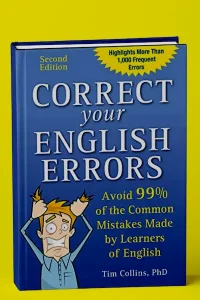The bestselling ESL guide—now with extra review exercises to reinforce lessons learned. Do you tend to repeat the same mistakes when you speak or write in English? This fun and engaging guide will help you communicate like a native English speaker on a consistent basis.
Correct Your English Errors, Second Edition is a comprehensive guide to correcting the bad habits that can leave your audience confused. This skill-building book clearly explains all the key elements of English grammar and provides hundreds of examples of errors learners often make—all presented in color to make them stand out and easier to avoid.
Correct Your English Errors
The purpose of this book is to identify the most common trouble spots for English language learners, to provide a basis for understanding why these trouble spots cause difficulties, and to offer guidance and practice for avoiding potential errors.
Many errors commonly made by speakers and learners of a second language are caused by transferring patterns and features of the native language to the new language. This happens in all aspects of language from pronunciation to word-formation to sentence structure:
- Difficulty in saying an English sound arises because the first language does not have such a sound.
- Double letters are omitted from English words because the first language’s spelling system does not have double letters.
- Verb endings to show tense or noun endings to show plurals are omitted because the first language does not add such suffixes to these words.
- Adjectives are placed after, rather than before, nouns because the first language follows that pattern.
- “Taller from” is said instead of “taller than” because that’s the pattern in the first language.
Another source of error is the learning process itself. That is, learners tend to overapply or misapply patterns and rules in the new language, do not learn exceptions to the rules, or do not apply the rules fully. Here are examples of these kinds of errors:
- Applying the regular -ed past-tense ending to irregular verbs: I went home early yesterday.
- Using more with the adjective heavy (which requires the -er ending) because the rule that two-syllable adjectives ending in -y use -er, not more, was not fully learned.
- Using asleep in front of a noun because the rule that a certain small group of adjectives, including asleep, are used only after a linking verb was not fully learned.


